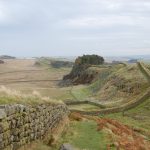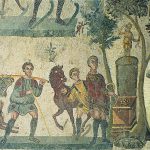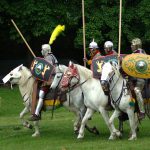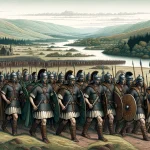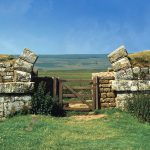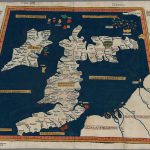Castle Hill Fort
Antonine Wall Fort
Like many places along the line of the Wall, it is speculated that the first Roman military presence at Castle Hill was established during the campaigns of governor Agricola sometime around 81AD, and the site later re-used during the Antonine period. In this case there is absolutely no evidence to validate this claim.
According to Roy the area available for occupation within the ramparts of the Castle Hill fort measure 320 ft. from east to west by 210 ft. north-south (c.98 x 64 m), an area of just over 1½ acres (c.0.6 ha). There is a single gateway located centrally in the south side. The rampart wall makes an abrupt change of alignment at the top of the hill, altering its course from almost due west to south-west, crossing the brook at the bottom of Castle Hill and then turning west once more to climb Hutcheson Hill to the fortlet at Cleddans. The fort has not yet been excavated and there are no known coins or significant finds reported other than the few surviving monumental inscriptions from the vicinity.
There are five inscribed stones recorded by R.I.B. from the neighbourhood of the Castle Hill fort: an ansate tablet found in 1698 built into a cottage at Castlehill (RIB2196); an altarstone found in 1826 during ploughing ‘a few hundred yards east of the fort’ (RIB 2195); a sandstone tablet found 1865 at the west end of Hutcheson Hill (RIB 2198); a distance slab ploughed up at the western end of Hutcheson Hill in 1969 (RIB 3507), and a panelled tablet found in fields 100 yards south-west of the fort in 1847, broken on the right by the plough and bearing an image of boar running left beneath the text (RIB 2197); all except RIB2198 are now housed in the Hunterian Museum. A copy of RIB2198 is in the museum (the original was taken to Chicago and destroyed in the fire of 1871).
Military Units at Castle Hill
RIB 2196 - Distance Slab of the Sixth Legion
To the Emperor Caesar Titus Aelius Hadrianus Antoninus Augustus Pius, father of his country, a detachment of the Sixth Legion Victrix Pia Fidelis (built this) for a distance of 3,666½ paces.
HADRIANO ANTONINO
AVG ▸ PIO P ▸ P ▸ VEXILLATÍ¡IO
LEG ▸ VI ▸ VICTÍ¡R P &rtrif
5. For s(emis) see n. to RIB 2193. Lhuyd and Gordon wrongly assign it to New Kilpatrick. Anderson confuses its provenance with that of RIB 2193 and assigns it to Summerston (see G. Macdonald RWS (1934) 375).
RIB 2195 - Altar dedicated to the Goddesses of the Parade-ground and Britannia
To the Goddesses of the Parade-ground and Britannia Quintus Pisentius Justus, prefect of the Fourth Cohort of Gauls, gladly, willingly, and deservedly fulfilled his vow.
TRIBVS ▸ ET
BRIÍ¡TANNI
Q PÍ¡ISEÍ¡NÍ¡TIVS
IVSTVS ▸ PREF
COH IIII GAL
V ▸ S L ▸ L ▸ M ▸
3. Domaszewski interprets as Britanni(cis Matribus), others as Britanni(ae).
The name of this auxiliary regiment occurs on a single altarstone dedicated by a man who styles himself a praefectus (vide supra). A prefect was placed in charge of either a fully-mounted cavalry ala or a part-mounted, mixed infantry cohort, whereas the commander of a standard auxiliary infantry cohort was usually a military tribune, sometimes an experienced legionary centurion. It is evident from this stone that the Fourth Cohort of Gauls was a part-mounted unit, a cohors equitata, presumably with a nominal strength of five-hundred men, a cohors quingenaria. This auxiliary unit was recruited from among the men belonging to the various tribes of the Gallic provinces, modern day France, the fourth regiment to have been so formed. They are one of only a few Auxiliary regiments attested on inscriptions from the Antonine Wall.
RIB 2198 - Distance Slab of the Twentieth Legion
For the Emperor Caesar Titus Aelius Hadrianus Antoninus Augustus Pius, father of his country, a detachment of the Twentieth Legion Valeria Victrix built this for a distance of 3000 feet.
AEL ▸ HADR
IANO ▸ AN
TONINO ▸ AVG ▸
PIO ▸ P ▸ P ▸ VEX ▸
LEG ▸
8. For p(er) p(edum) … (milia) see RIB 2197 n. Addenda from RIB+add. (1995): The text is almost identical with that of the new Hutcheson Hill ‘distance slab’ (Brit. i (1970), 309 No. 19 = RIB 3507).
RIB 3507 - Distance slab of the Twentieth Legion Valeria Victrix
For the Emperor Caesar Titus Aelius Hadrianus Antoninus Augustus Pius, father of his country, a detachment of the Twentieth Legion Valeria Victrix built (this Wall) for a distance of 3000 feet.
T AE ▸
HADRI
ANO
ANTO
NINO
AVG ▸
PIO ▸ P ▸ P
VEX ▸ LEG
XX ▸ V ▸ V ▸
FEC
Stylistically this slab is close to RIB 2208, and may have been carved by the same sculptor. They also share the unusual form of A and H with angled cross-bar which is peculiar to distance slabs of the Twentieth Legion (RIB 2197, 2198, 2199 and 2206, but not 2173), and occurs elsewhere in Britain only at the legion’s base of Chester, in RIB 461 (a Greek altar) and 497 (a tombstone). The two slabs also abbreviate Aelio to AE (not AEL), like RIB 2199 and 2206, but not RIB 1273 and 2198. Apart from AE instead of AEL, the text of RIB 3507 is identical with that of the other Hutcheson Hill slab (RIB 2198). They are the only pair of identical texts marking the end of a sector, in this instance the 3000 feet which began with RIB 2197 at Castlehill. Since both Hutcheson Hill slabs carried cramp-holes, neither can be regarded as a ‘waster’, and Steer has suggested that one was originally set in the south face of the Wall and the other in the north. This would then be analogous to the location of RIB 1362 and 1363, opposite each other on the Vallum mounds of Hadrian’s Wall.
RIB 2197 - Distance Slab of the Twentieth Legion Valeria Victrix
For the Emperor Caesar Titus Aelius Hadrianus Antoninus Augustus Pius, father of his country, a detachment of the Twentieth Legion Valeria Victrix (built this) for a distance of 3000 feet.
T ▸ AELIO ▸
HADRIANO ▸
ANTONINO
AVG ▸ PIO ▸ P ▸ P
VEX ▸ LEG ▸ XX ▸ V V
P ▸
For the genitive case inserted between per and its noun see CIL ix 5959 (ILS 209) per passuum … (milia). See also RIB 2198, 2206, 2208.
References for Castle Hill
- The Roman Wall in Scotland by Sir George MacDonald (Oxford, 2nd Ed. 1934) pp.326-8;
- Air Reconnaissance of North Britain by J.K. St. Joseph in J.R.S. xli (1951) pp.61/2;
- The Roman Inscriptions of Britain by R.G. Collingwood and R.P. Wright (Oxford 1965);
- Britannia i (1970) pp.309-10 #19; Chronology of the Ancient World by E.J. Bickerman (Thames & Hudson, London, 1980);
- Chronicle of the Roman Emperors by Chris Scarre (Thames & Hudson, London, 1995);
- A Survey of the Coin Finds from the Antonine Wall by Richard Abdy in Britannia xxxiii (2002) pp.189-217;
Roman Roads near Castle Hill
Antonine Wall: E (1.5) to Bearsden (Strathclyde) Antonine Wall: W (1) to Cleddans (Strathclyde)
Sites near Castle Hill Fort
- Cleddans Roman fortlet (2 km)
Antonine Wall Fortlet and Fortlet - Bearsden Roman Fort (2 km)
Antonine Wall Fort - Duntocher Roman Fort (3 km)
Antonine Wall Fort and Fortlet - Summerston Roman Fortlet (5 km)
Antonine Wall Fortlet, Fortlet and Marching or Temporary Camp - Balmuildy Bridge (6 km)
Roman Bridges - Balmuildy (Medio) Roman Fort (6 km)
Antonine Wall Fort - Balmuildy Camp (6 km)
Marching or Temporary Camp - Old Kilpatric Roman Fort (7 km)
Antonine Wall Fort - Wilderness Plantation Fortlet (7 km)
Antonine Wall Fortlet and Fortlet - Cadder Roman Fort (9 km)
Antonine Wall Fort
